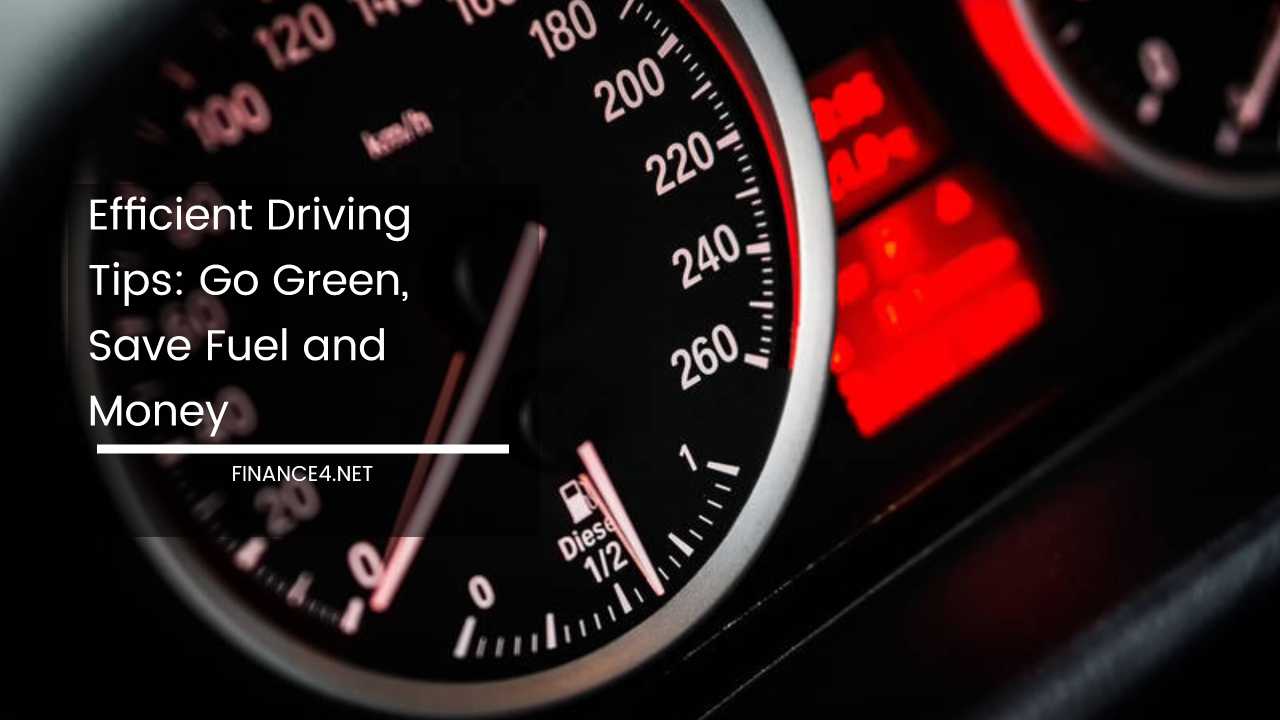Efficient Driving Tips: Go Green, Save Fuel and Money

In today’s world, with rising fuel costs and growing environmental concerns, maximizing fuel efficiency has become a top priority for drivers. It’s a win-win situation: you save money at the pump while contributing to a cleaner, healthier planet.
By adopting a few simple yet effective driving techniques, you can achieve an average fuel savings of up to 15%. Let’s delve deeper into the multifaceted benefits of efficient driving and explore practical tips to become a fuel-conscious driver.
The Virtuous Circle of Efficient Driving
- Environmental Champion: Reducing CO2 emissions through efficient driving directly combats global warming. Lower fuel consumption also leads to less air pollution, particularly in urban areas. This translates to cleaner air for everyone, promoting respiratory health and reducing the impact on ecosystems.
- Economic Advantage: Saving fuel translates to significant cost savings. By maximizing fuel efficiency, you put more money back in your pocket. Additionally, proper car maintenance practices associated with efficient driving can extend the lifespan of tires, brakes, and other components, reducing overall maintenance expenses.
- Safety First: Efficient driving techniques often promote safer driving practices. Smoother acceleration, maintaining a steady speed, and anticipating traffic flow all contribute to increased reaction time and reduced risk of accidents. This translates to a safer driving experience for yourself, passengers, and fellow motorists.
- Enhanced Comfort: You might be surprised to learn that efficient driving often leads to a smoother and more comfortable ride. Less aggressive acceleration and braking create a calmer driving experience with fewer jolts and stops. This translates to a more relaxing journey for the driver and passengers.
Beyond the Basics: Mastering Efficient Driving
-
Minimize Weight and Load: Before setting off, declutter your car. Extra weight forces the engine to work harder, leading to increased fuel consumption. Additionally, aim for a balanced weight distribution within the vehicle for optimal performance. Avoid carrying unnecessary items on your roof; consider using a trunk rack instead, as roof-mounted cargo significantly increases wind resistance and fuel use.
-
Planning is Key: Utilize navigation systems or map out your trip beforehand to avoid unnecessary turns and city driving. Stop-and-go traffic in urban areas can double your fuel consumption compared to highway driving. Planning allows you to choose routes with fewer traffic lights and congestion, optimizing fuel efficiency.
-
Consolidate Short Trips: Whenever possible, combine short errands into one trip. Short journeys with a cold engine lead to peak fuel consumption during the warm-up phase. Combining errands allows the engine to reach optimal operating temperature sooner, improving fuel efficiency for all your stops.
-
Maintain Proper Tire Pressure: Don’t underestimate the importance of tire pressure. Regularly check your tire pressure, ideally once a month, and maintain the recommended level as specified in your car’s manual. Underinflated tires create more rolling resistance, forcing the engine to work harder and burn more fuel. Properly inflated tires also last longer and enhance ride comfort and handling.
-
Scheduled Maintenance Matters: Regular car servicing as per the manufacturer’s guidelines is crucial for both safety and fuel efficiency. A well-maintained car operates at its peak, optimizing fuel consumption. Scheduled maintenance often includes replacing air filters, spark plugs, and engine oil, all of which can contribute to improved fuel economy when functioning properly.
-
Shift Gears Efficiently: Higher gears translate to lower engine RPMs and lower fuel use. Modern engines with advanced technology allow for earlier gear changes without compromising engine performance. Aim to shift gears between 2,000 and 2,500 rpm for optimal fuel economy. Consult your car’s manual for specific recommendations on gear shifting based on your vehicle’s make and model.
-
Utilize Electrical Accessories Wisely: Features like heated seats, rear window defoggers, and fog lights all consume energy. Air conditioning is a major culprit, significantly increasing fuel consumption by up to 25%. Use these features only when absolutely necessary. Consider alternative methods to stay comfortable; for example, open a window for a short period instead of relying solely on air conditioning.
-
Become a Traffic Flow Master: Knowing traffic patterns and anticipating congestion helps you avoid unnecessary braking and acceleration. This allows you to maintain a lower engine speed and reduce fuel consumption. Look ahead, observe traffic flow, and adjust your speed accordingly. Avoid coasting in neutral, as it can be less efficient than maintaining a gear and using engine braking to slow down.
-
Minimize Air Resistance: Keeping windows closed and using the car’s ventilation system can reduce fuel consumption by up to 5%. Closed windows create a more aerodynamic profile, reducing wind resistance and improving fuel efficiency. However, if fresh air is needed, consider cracking a window slightly instead of fully opening it.
- Turn Off the Engine During Idling: If you anticipate a wait time exceeding 30-60 seconds, turn off the engine whenever possible. Cars idling at stoplights or in traffic jams waste fuel unnecessarily. Modern vehicles often have features like automatic stop-start that can help with this; familiarize yourself with your car’s specific features.
- Maintain a Steady Speed: Frequent acceleration and deceleration significantly decrease fuel efficiency. Utilize cruise control on highways whenever possible, particularly on flat or slightly inclined stretches, to maintain a constant speed and optimize fuel consumption. However, be cautious when using cruise control on hilly terrain or in stop-and-go traffic, as it may lead to unnecessary braking and acceleration.
- Master the Art of Braking: Aggressive braking is a major fuel guzzler. Anticipate traffic flow and potential slowdowns to avoid slamming on the brakes. Apply gentle and gradual pressure when braking to slow down smoothly and efficiently. This technique not only saves fuel but also reduces wear and tear on your brake pads.
- Choose the Right Fuel: Consult your car’s manual to determine the recommended fuel grade. Using a higher-octane fuel than your engine requires won’t necessarily improve performance and can actually be less economical. Opt for the fuel grade specified by the manufacturer for optimal efficiency.
- Carpool or Use Public Transportation: When possible, consider carpooling with colleagues or friends for work or errands. This reduces the number of vehicles on the road, thereby reducing overall fuel consumption and emissions. Additionally, consider utilizing public transportation options like buses, trains, or subways for everyday commutes. This can significantly reduce your personal fuel consumption and environmental impact.
- Invest in Fuel-Efficient Vehicles: As technology advances, car manufacturers are constantly developing more fuel-efficient vehicles. If you’re in the market for a new car, consider researching fuel-efficient options like hybrid or electric vehicles. These models offer significant improvements in fuel economy and reduced emissions compared to traditional gasoline-powered vehicles.
Beyond Efficiency: Eco-Conscious Driving
While maximizing fuel efficiency is a core principle, there are additional ways to become an eco-conscious driver. Here are some strategies that extend beyond fuel economy and contribute to a more sustainable transportation experience:
-
Reduce Vehicle Idling Time: In addition to turning off the engine during extended stops, consider minimizing idling time even during shorter waits. Look for ways to reduce your reliance on the car’s climate control system. Park in shaded areas whenever possible to avoid excessive heat buildup that might tempt you to use the air conditioning before setting off.
-
Proper Car Maintenance for Reduced Emissions: Regular car maintenance goes beyond just fuel efficiency. A poorly maintained car can have higher emissions due to incomplete combustion or malfunctioning emission control systems. Ensure your car receives scheduled maintenance as recommended by the manufacturer. This includes replacing spark plugs, air filters, and oxygen sensors at specified intervals. Properly functioning emission control systems significantly reduce harmful pollutants released into the atmosphere.
-
Eco-Friendly Car Care Products: Many car care products contain harsh chemicals that can be harmful to the environment when disposed of improperly. Opt for eco-friendly car cleaning products made with biodegradable ingredients. Additionally, consider using waterless car washes that minimize water usage.
-
Lighten Up Your Driving Style: Efficient driving isn’t just about following specific techniques; it’s also about cultivating a mindful driving style. Avoid aggressive acceleration, harsh braking, and unnecessary speeding. These habits not only decrease fuel efficiency but also contribute to increased wear and tear on your vehicle. Practice smooth acceleration, gentle braking, and maintaining a steady speed for a more relaxed and environmentally friendly driving experience.
-
Responsible Carpooling and Public Transportation: While carpooling reduces the number of vehicles on the road, consider the environmental impact of the combined passengers. If everyone in the carpool lives in the same general vicinity, carpooling can be highly beneficial. However, for longer commutes with passengers traveling in different directions, public transportation might be a more eco-conscious option. Utilize resources like ride-sharing apps or public transportation schedules to find the most efficient and environmentally friendly way to travel with others.
-
Advocate for Sustainable Transportation Infrastructure: As an environmentally conscious driver, you can extend your impact beyond your personal driving habits. Consider supporting initiatives that promote sustainable transportation infrastructure. This could involve advocating for the expansion of public transportation systems, the development of dedicated bike lanes, or policies that encourage the adoption of electric vehicles.
Final Thoughts
Efficient driving offers a win-win situation: you save money on fuel and reduce your environmental impact. By adopting simple techniques like maintaining proper tire pressure, avoiding unnecessary weight in your car, and minimizing idling time, you can achieve significant fuel savings. Efficient driving also promotes smoother and safer journeys.
Beyond these core practices, eco-conscious drivers can take further steps like using eco-friendly car care products, practicing a mindful driving style, and advocating for sustainable transportation infrastructure.
The future of transportation is bright, with advancements in electric vehicles, hybrid options, and autonomous vehicles promising even greater efficiency and reduced emissions.
By incorporating these tips and staying informed about new technologies, you can become a responsible driver who contributes to a cleaner and more sustainable future for all.



